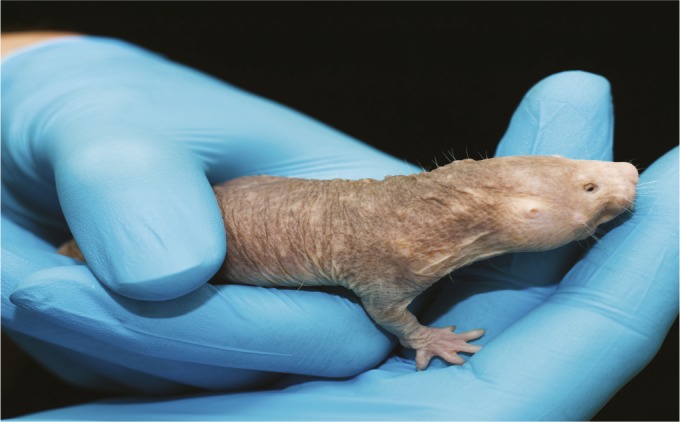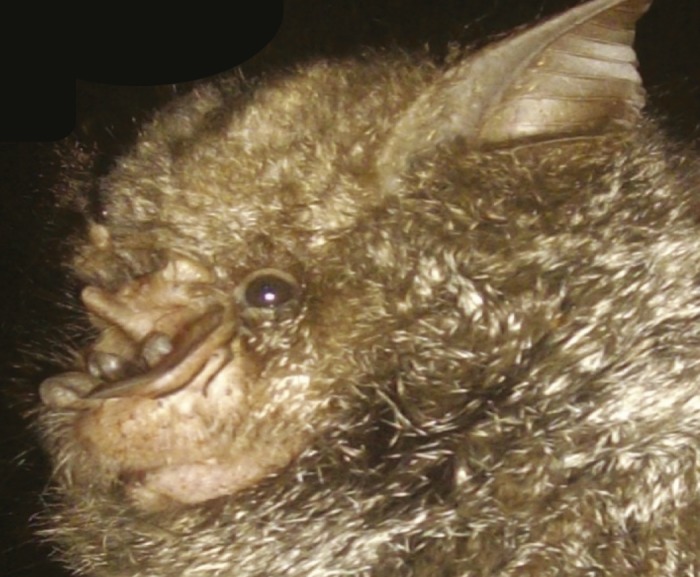Molecular clues to the naked mole-rat’s exceptional longevity

Naked mole rat from the University of Rochester colony. Image courtesy of the University of Rochester.
Naked mole-rats live about 10 times longer than other rodents of their size and are resistant to the increased frailty that typically accompanies aging in most animals. However, the molecular mechanisms underlying the naked mole-rat’s longevity remain unclear. Jorge Azpurua et al. (pp. 17350–17355) examined the naked mole-rat’s ribosomes, the cellular protein manufacturing machinery, because alterations in protein translation—the process by which ribosomes synthesize proteins from an RNA template—have previously been implicated in aging in diverse organisms. The authors found that the naked mole-rat’s 28S ribosomal RNA (rRNA), one of the structural components of eukaryotic ribosomes, undergoes an unusual cleavage into two fragments of unequal size, whereas mouse rRNA does not. Despite these structural differences, the translation rate of the naked mole-rat ribosome was similar to that of the mouse, the authors report. By contrast, cells from naked mole-rats had higher protein translation fidelity than mouse cells, even when the naked mole-rat cells were forced to grow more quickly than normal. The findings suggest that the structure of the 28S rRNA in naked mole-rats may increase the fidelity of protein translation, which may contribute to the animal’s longevity, according to the authors. — N.Z.
Climate change in the Everglades 2,800 years ago
The Everglades in south Florida once covered more than 2.5 million acres, providing a conduit for Lake Okeechobee runoff to drain into the sea. Over the past century, however, massive projects have converted wetlands into agricultural fields and Water Conservation Areas, altering the hydrology and nutrient fluxes so pervasively that current conditions may not reflect the ecosystem’s past influences. Citing earlier work suggesting that wind-blown dust constitutes an overlooked nutrient source for large peatlands, Paul Glaser et al. (pp. 17211–17216) analyzed a sediment core from the Northeast Shark River Slough in Everglades National Park. Prior to 2,800 years ago, the authors report, a wet climatic period prevailed with high influxes of Saharan dust, during which typical slough vegetation dominated the principal drainage outlet of the Everglades. But since then a dry regime has persisted with declines in both dust deposition and indicators of primary productivity, while vegetation, such as the sawgrass and tree islands that give the region its distinctive appearance, has emerged. The abrupt climatic change, the authors suggest, likely reflects a shift in the Bermuda High, a migrating, subtropical area of high pressure in the North Atlantic Ocean, to the southeast that shunted tropical storms to the south of Florida into the Gulf of Mexico. — T. J.
High diversity of malaria parasites reveals bats’ immunological tolerance

Hipposideros cyclops harbors malaria parasites that are closely related to rodent Plasmodium.
Of the more than 550 species in the order Haemosporida, just six protozoan parasites of the genus Plasmodium are known to cause human malaria. Researchers have long tried to understand the evolution and phylogenetic context of these human-infecting species to help combat malaria. Juliane Schaer et al. (pp. 17415–17419) conducted a systematic analysis of Haemosporida in a broad species assemblage of bats from three remnants of the Upper Guinean forest ecosystem, one of the world’s most biologically diverse terrestrial ecosystems. Within the cohort of 274 bats belonging to seven families and 31 species, the authors found an unexpectedly high diversity of malaria parasites including two lineages that are both closely related to Plasmodium parasites in rodents and consistent with having switched between the hosts during their evolutionary history. The abundance of malaria parasite infections in bats, the authors report, supports the view that these animals—well-established reservoir hosts for numerous pathogens—have unusually high immunological tolerance. Furthermore, the findings suggest that malaria parasites in bats have repeatedly evolved from disease-causing replication in red blood cells to a less pathogenic propagation in liver tissue, according to the authors. — T.J
Molecular insight into a female infertility treatment

Kawamura holding the newborn.
For the 1% of women of reproductive age who suffer from primary ovarian insufficiency (POI), menopausal symptoms appear before the age of 40 and a deficiency of egg-bearing ovarian follicles leads to infertility; for many such women egg donation is the only path to pregnancy. Kazuhiro Kawamura et al. (pp. 17474–17479) demonstrated that ovary fragmentation, a technique that forms the basis of some infertility treatments, likely disrupts a molecular signaling cascade called the Hippo pathway, which regulates organ size and promotes follicle growth in mice and humans. In addition, pharmacological stimulation of an alternative signaling cascade called the Akt pathway boosted follicle growth. Extending the findings, the authors laparoscopically removed ovaries containing residual follicles from 13 women with POI, cut the ovaries into strips, fragmented the strips into 1–2 mm2 cubes, treated the cubes with Akt-stimulating drugs for 2 days, transplanted the treated cubes within the women’s Fallopian tubes, monitored follicle growth and retrieved mature oocytes from five women, performed in vitro fertilization using their husbands’ sperm, and transplanted the resulting embryos into the women. Among the patients, the authors report, a 30-year-old woman gave birth to a healthy male baby at 37 weeks and 2 days of pregnancy. According to the authors, ovarian fragmentation, combined with Akt activation, might represent a potential approach to treating infertility in some women suffering from diminished ovarian function. — P.N.
Role of mosquito sugar transporter in malaria infection
Trehalose, an abundant sugar in many plants, fungi, bacteria, and invertebrates, protects cultured cells from a variety of environmental stresses. The mosquito Anopheles gambiae, a major vector for malaria in sub-Saharan Africa, carries trehalose as the predominant sugar in its hemolymph. Kun Liu et al. (pp. 17504–17509) examined the role of trehalose in protecting A. gambiae from desiccation and heat stress, as well as in propagation of the malaria parasite Plasmodium falciparum. The authors altered trehalose levels by manipulating expression of the AgTreT1 gene, which encodes the transporter that moves trehalose from the fat body, where it is synthesized, to the hemolymph. AgTreT1 expression and hemolymph trehalose levels were observed to increase in response to low humidity or excessive temperature. Silencing of AgTreT1 by RNA interference reduced trehalose levels by 40% and impaired the mosquito's ability to survive conditions of dehydration or high heat. Eight days after AgTreT1-silenced mosquitoes consumed a blood meal containing parasites, the number of P. falciparum oocysts recovered from the mosquito mid gut was reduced by an average of 72%, compared with unsilenced mosquitoes. According to the authors, AgTreT1 plays a significant role in both stress adaptation and parasite growth in A. gambiae and may be a target for malaria control. — C.B.
Genomic evolution of a dysentery bacterium

Canals of Ho Chi Minh City: Possible sites of origin of new Shigella sonnei clones in Vietnam. Image courtesy of Mayo Foundation for Medical Education and Research. All rights reserved.
Since emerging in Europe during the 1500s, the bacterium Shigella sonnei has spawned a multidrug-resistant clade known as Global III that is now a dominant cause of dysentery in many endemic areas of the world. Kathryn Holt et al. (pp. 17522–17527) have uncovered a high-resolution view of the genome of S. sonnei as the pathogen entered the Vietnamese population and evolved over 15 years. The authors sequenced the genomes of 263 isolates of the pathogen, estimated to cause more than 160 million cases of dysentery and 1 million related deaths every year. Isolates of S. sonnei were obtained from patients who had been treated at various hospitals in Vietnam during a 15 year period, with all but two of the isolates belonging to the pandemic Global III clade. The analysis revealed that S. sonnei underwent several changes after its introduction to Vietnam in the 1980s. Bacterial populations in some areas of Vietnam accumulated pathogenesis-boosting mutations that were retained as the bacteria replicated and spread geographically, gradually becoming genetic fixtures in the local S. sonnei population. According to the authors, the study provides insight into the microevolution of a pioneering human pathogen during its establishment in a human population. — A.G.


